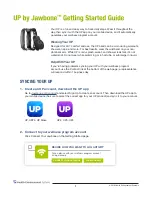
20
Non-Volatile Memory
Your Oxygen controller features non-volatile memory, which allows for automatic saving of presets after powering down and
restarting. The current controller and channel assignments are stored whether you have stored the setup to a memory location or
not. The Program, Bank LSB and Bank MSB data, Global Channel setting, MIDI Out from USB setting and last used memory preset
are also stored.
Memory Dump
Press the Advanced Function button, then the Mem Dump key to send out SysEx data packets that represent the 20 memories set up
in the Oxygen controller. This can be used for storing or backing up the contents of the memory presets externally.
It is possible to record the complete Memory Dump to a standard sequencer. Recall the Memory Dump by playing the MIDI track
containing the recorded Memory Dump, making sure that the Oxygen’s drivers are selected as the output for that particular track.
A Memory Dump or a Memory Send does not affect the current controller assignments to the keyboard. Recall a preset to access the
new memory settings after a Memory Dump has been sent to the keyboard.
Press the Edit button, then the Mem Dump key to send out a number of SysEx data packets that represent the 20 memories set up in
the Oxygen. This can be used for storing or backing up the contents of the memory presets externally.
Assigning the Device ID (not available on 25-note model)
The Device ID is a way of differentiating between multiple keyboards. Press the Advanced Function button, then the Dev ID key to
assign a Device ID to your Oxygen controller. The default Device ID is 127 when a Memory Dump is performed. It is recommended
to keep the Device ID setting as 127.
If a Device ID is assigned to any number other than 127, the Memory Dump performed will be specific to the Oxygen, with the same
device ID. If the Device ID of the Oxygen differs from the one recorded with the Memory Dump, the data will be ignored.
When the Dev ID key is pressed, the LCD display represents the assigned Device ID. It is possible to enter a new Device ID using the
numerical data entry keys. Press the Enter key to confirm.
For more information on SysEx messages and device ID, please reference the “MIDI Messages Explained” section of this manual.
Returning to the Factory Default Setting
You can reset the Oxygen controller back to the factory default settings on power-up by holding down the Data - and + buttons.
Note
: Restoring the factory presets will erase all set-ups you have stored to memory.
11 › MIDI Messages Defined
Program and Bank Changes
The original GM MIDI specification allowed for only 128 voices, numbered from 0-127. It is possible to access a different voice by
sending a Program Change.
In order to expand on the GM set of voices, Bank Changes were devised. Each bank contains 128 patches that can be accessed
using a Program Change. 16,384 available banks can be accessed by sending a 14-bit Bank Change message. The first 7 bits of this
message are sent in a single byte known as the Bank LSB. The last 7 bits are specified by another byte known as the Bank MSB. The
BANK LSB is more commonly used. This allows for 128 Bank Changes, and often there is no need to send a Bank MSB.
Almost all MIDI devices respond to the Program Change, but some that do not conform to the GM set of voices use the Program
Change message for other purposes. Many VST instruments have adopted this approach, allowing the use of a Program Change to
change the instrument patch. (The FM7 by Native Instruments is an example of this.)
Bank Changes are used more rarely. Bank Changes are useful in manufacturers’ extensions to the MIDI specification, such as
Roland's GS specification and Yamaha's XG specification. Both of these require the specification of a Bank Change in order to access
the extra voices and effects that these specifications provide.
Sending Program, Bank LSB and Bank MSB data is done by pressing the Edit button followed by the Program, Bank LSB or Bank MSB
key, and then entering the Program or Bank Change desired.









































